
French minicard by Chocolat Félix Potin, Second Series, 1908. Photo: anonymous.
Annette Kellerman (1886-1975) was an Australian professional swimmer, vaudeville star, actress and writer. When she was six, she started swimming. In 1905, she was the first woman to attempt to swim the English Channel, but she gave up after three failed attempts. She was the first woman to wear a one-piece swimming costume and created her own line of swimming costumes. After her swimming career, she pursued a film career. In 1911, she was the first actress to wear a mermaid suit in a film. She was the first leading actress who appeared fully nude in A Daughter of the Gods (1916), the first film with a budget of $1 million. Kellerman appeared in one of the last films made in Prizma Colour, Venus of the South Seas (1924). This is also her only feature film that has survived in full. One of her Vitagraph shorts also survives, Jepthah’s Daughter: A Biblical Tragedy (1909). Recently, partial prints of Neptune’s Daughter and Siren of the Sea were uncovered. Kellermann did all of her stunts herself, sometimes resulting in serious injuries. She advised for the Esther Williams movie on her life, Million Dollar Mermaid (1952).

French minicard by Chocolat Félix Potin, Second Series, 1908. Photo: Léopold-Émile Reutlinger.
Legendary actress Cécile Sorel (1873-1966) was the ‘queen of the French stage’ during the Belle Epoque, the period between the Paris Exposition of 1900 and the First World War. Her public appearances, often in extravagant costumes, created a sensation. During her long life, she played in five films.

French minicard by Chocolat Félix Potin, Second Series, 1908. Photo: Léopold-Émile Reutlinger.
French comedian Polin (1863-1927) was one of the greatest stars of the café-concerts of Paris. His interpretations were sober and had nuance and finesse, which were rare in the café-concerts. From 1910 on, he also appeared in film and theatre, including Sacha Guitry's play 'Le Grand Duc' (The Grand Duke, 1921) with Lucien and Sacha Guitry and Yvonne Printemps.

French minicard by Chocolat Félix Potin, Second Series, 1908. Photo: Paul Darby.
French singer of the Belle Epoque Félix Mayol (1872-1941) created almost 500 songs. In 1895 he had his breakthrough performing in a campy, effeminate way. His improbable hair tassel gave him the nickname of "the red-toupeed artist" or "flame of punch" and inspired many imitators. After a 1905 phonoscènes series at Gaumont, Mayol acted in five more films, including Le filon du Bouif (Louis Osmont, 1922), and two early sound films, Aux urnes, citoyens!/Tu sera député (Jean Hémard, 1932) and La dame de chez Maxim's (Alexander Korda, 1933) starring Florelle.

French minicard by Chocolat Félix Potin, Second Series, 1908. Photo: Eugène Pirou, Paris.
Georges-Antoine Rochegrosse (1859-1938) was a French painter, decorator and illustrator. Through his encounter with the culture of Algeria, he became a painter of Orientalism and received numerous awards for his work. His book illustrations for the 1900 edition of 'Salammbô' by Gustave Flaubert were used in the film Cabiria (Giovanni Patrone, 1914).
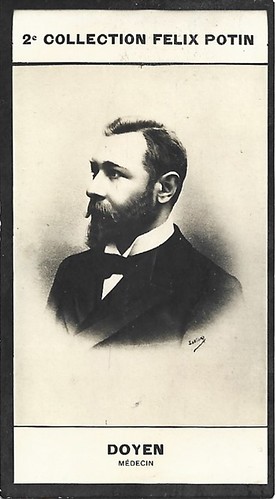
French minicard by Chocolat Félix Potin, Second Series, 1908. Photo: Sartony.
Eugène Louis Doyen (1859-1916) was a French surgeon of international renown, cited by the Russian writer Mikhail Bulgakov as the model for Marcel Proust's character Cottard, and vilified by Léon Daudet in 'Les Morticoles' as Doctor Bradilin. Doyen is considered one of the renovators of French surgery at the end of the 19th century, despite his inaccurate theories on cancer. We owe him very important improvements in surgical technique. From 1898, Doyen and Clément Maurice (organiser of the first Lumière shows) shot some sixty film sequences which recorded Doyen's surgical operations.

French minicard by Chocolat Félix Potin, Second Series, 1908. Photo: Scherer & Nabholz.
Russian writer Maxim Gorky (1868-1936) was one of the founders of socialist realism in literature and was politically and intellectually committed to the Bolshevik revolutionaries. Among Gorky's most famous works are his early short stories, written in the 1890s; his plays 'The Philistines' (1901), 'Na dne'/The Lower Depths' (1902) and 'Children of the Sun' (1905); his autobiographical trilogy, 'Detstvo/My Childhood', 'V lyudyakh/In the World', and 'Moi universitety/My Universities' (1913–1923); and his novel, 'Mat/Mother' (1906). 'Mat' was made into a notable silent film by Vsevolod Pudovkin, Mat/The Mother (1926) and dramatised by Bertolt Brecht in 'Die Mutter' (1930–31).
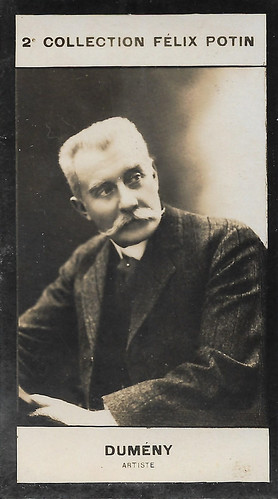
French minicard by Chocolat Félix Potin, Second Series, 1908. Photo: Henri Manuel.
Camille Dumény (1854-1920) was a French stage and screen actor. In 1904 he returned to the Théâtre du Gymnase Marie-Bell, in what was the most brilliant period of her career. Between 1909 and 1918, Dumény acted in 9 films, mainly at Pathé Frères He co-directed L'orgueil (1910), and directed L'empreinte de la patrie (1915). His last acting role was in Frères (Maurice Rémon, 1918), written by Jacques Grétillat.

French minicard by Chocolat Félix Potin, Second Series, 1908. Photo: .
Louis Botha (1862-1919) was the commander-in-chief of the Transvaal army during the Second Boer War and the first prime minister of the Union of South Africa.
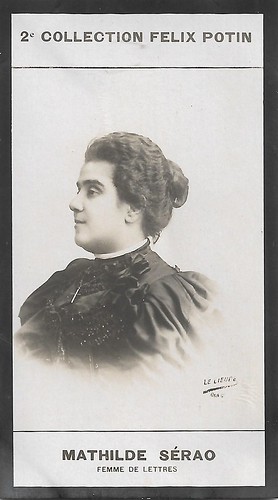
French minicard by Chocolat Félix Potin, Second Series, 1908. Photo: Le Lieure, Rome.
Matilde Serao (1856-1927) was an Italian journalist and novelist. She was the first woman called to edit an Italian newspaper, Il Corriere di Roma and later Il Giorno. Serao was also the co-founder and editor of the newspaper Il Mattino, and the author of several novels. She never won the Nobel Prize in Literature despite being nominated on six occasions.

French minicard by Chocolat Félix Potin, Second Series, 1908. Photo: Lafayette.
Guglielmo Marconi (1874-1937) was an Italian physicist, inventor and businessman. He was one of the inventors of the radio and wireless telegraphy. Together with Ferdinand Braun, he was co-recipient of the 1909 Nobel Prize in Physics "in recognition of his contributions to the development of wireless telegraphy". Marconi was also the founder of the first international broadcasting company.

French minicard by Chocolat Félix Potin, Second Series, 1908. Photo: Warszawi.
Writer and philanthropist Henryk Sienkiewicz (1846-1916) was the greatest Polish novelist of his time. He enjoyed international fame during his lifetime thanks to the immense success of his novel 'Quo vadis?' (1896, first published as a feuilleton in 1895), which earned him the Nobel Prize for Literature in 1905. He also campaigned for the rights of Poles, who were under Prussian and then Russian occupation. The widely translated 'Quo vadis?' was filmed in 1901, 1909, 1913, 1926, 1951 and 2001.

French minicard by Chocolat Félix Potin, Second Series, 1908. Photo: anonymous.
French wrestler Paul Pons (1864-1915) won the first title as world champion in Greco-Roman wrestling in 1898. Known as the Colossus, Pons was a blacksmith and mechanic by profession. Trained by Pietro Damiano, he became the national champion in Paris in 1891, then the first world wrestling champion in 1898, beating the Russian Pytlasiński. The championship passed to Bulgarian Nikola Petroff in 1900 when he defeated Pons at the Exposition Universelle in Paris.
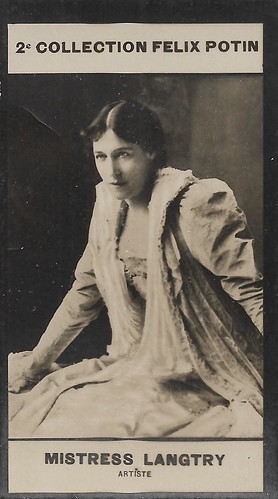
French minicard by Chocolat Félix Potin, Second Series, 1908. Photo: anonymous.
Lillie Langtry (1853-1929) was a highly successful British actress. Because of her beauty, her nickname was 'Jersey Lily'. She had several prominent lovers, including the Prince of Wales, and later King Edward VII. In 1879, Lillie made her debut as an actress at London's Haymarket Theatre. A year later, she toured several European countries. From 1882, Lillie performed in the United States. In 1886, her face was captured for a postage stamp issued in Jersey. In His Neighbor's Wife (Edwin S. Porter, 1913) Langtry starred opposite Sidney Mason in the role of Mrs Norton. It would be her only film appearance.

French minicard by Chocolat Félix Potin, Second Series, 1908. Photo: anonymous (probably: Félix).
Marthe Régnier (1880-1967) was a famous French stage actress and singer of the Belle Epoque and beyond. She launched her own perfume, designed fashion, and jewellery, and was the companion of Baron Rothschild. Regnier also acted in six silent and sound films.
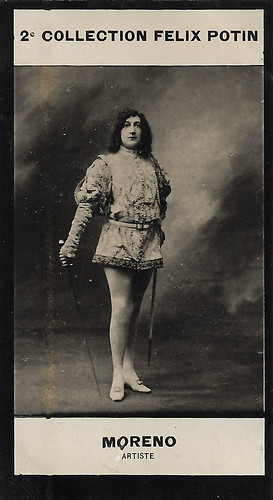
French minicard by Chocolat Félix Potin, Second Series, 1908. Photo: Roger-Viollet.
French stage and screen actress Marguerite Moreno (1871-1948) was engaged by the Comédie-Française in 1890. She acted with famous names on the French stage: Charles Le Bargy, Mounet-Sully, Julia Bartet, Coquelin sr. and Paul Mounet. Moreno also became the 'muse of the Symbolists', and poet Stéphane Mallarmé’s close friend. In 1915, she discovered cinema. In the silent era, she played Queen Anne of Austria in Vingt ans après (Henri Diamant-Berger, 1922). When sound cinema arrived in France, Moreno had an enormous increase in film roles. Together with Charles Dullin, Moreno played the evil couple Thenardier opposite Harry Baur as Jean Valjean in Les Misérables (Raymond Bernard, 1934).
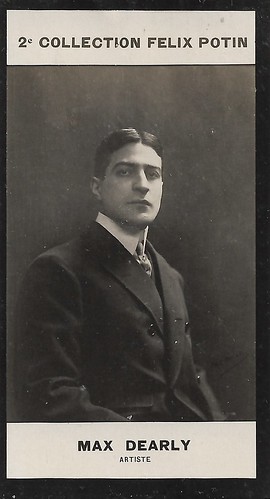
French minicard by Chocolat Félix Potin, Second Series, 1908. Photo: Paul Berger.
French actor Max Dearly (1874-1943) was famous for his roles in French film classics of the 1930s. In 1933 Dearly played the pharmacist Homais in Jean Renoir’s adaptation of Gustave Flaubert’s Madame Bovary. Memorable was also his part as the eccentric aristocrat Mr. Gillenormand, Marius’ grandfather in Les Misérables (Raymond Bernard, 1934). However, Dearly was above all an excellent actor in Parisian Vaudeville and revues.
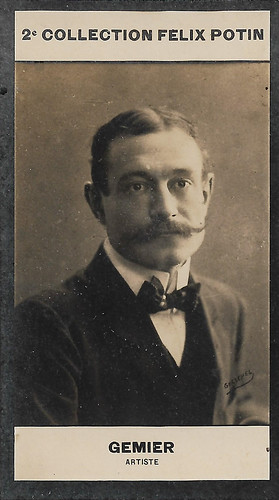
French minicard by Chocolat Félix Potin, Second Series, 1908. Photo: Aaron Gerschel.
Firmin Gémier (1869-1933) was an actor, director and theatre manager on the French stage, promotor of the Théâtre Populaire and founder of the first Théâtre National Populaire in Paris in 1920. He also acted in the French silent and sound cinema of the 1910s to the 1930s.

French minicard by Chocolat Félix Potin, Second Series, 1908. Photo: Léopold-Émile Reutlinger.
Félix Huguenet (1858-1926) only stayed two years with the Comédie Française (1906-1908) but had a rich stage career between the 1880s and the 1920s. He played in four films, including Mademoiselle de La Seiglière (André Antoine, 1921).
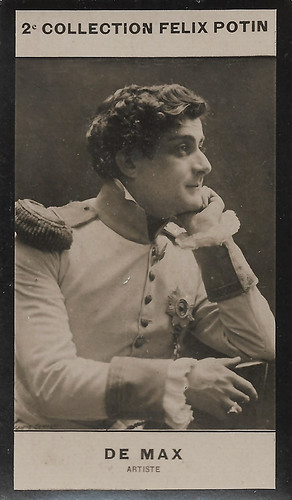
French minicard by Chocolat Félix Potin, Second Series, 1908. Photo: Paul Berger.
Actor Édouard de Max (1869-1924) was a leading man and 'monstre sacré' of the French stage. He also appeared in silent films of the 1910s and 1920s, including two versions of Les trois mousquetaires/The Three Musketeers.

French minicard by Chocolat Félix Potin, Second Series, 1908. Photo: Pierre Petit, Paris.
Italian actor Ermete Novelli (1851-1919) was a legendary 'monstre sacré' of the theatre. In the 1910s he appeared in films by Film d'Arte Italiana, Ambrosio and Raggio Film.
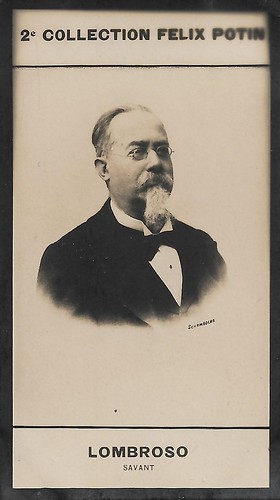
French minicard by Chocolat Félix Potin, Second Series, 1908. Photo: Michele Schemboche, Rome, Turin, Naples.
Cesare Lombroso (1835- 1909) was an Italian professor of forensic medicine and one of the founders of the Italian School of Criminology. He is famous for his theses on the "born criminal". He tried to identify criminals as a hereditary class that could be distinguished by physical appearance. His theories were influenced by the theory of degeneration, racialism and transformism. Lombroso was criticized for his prejudice and racism, but also for his pseudo-scientific studies. Afterward, Lombroso adjusted his theory, believing that crime is the result of both individual (biological) and social factors.
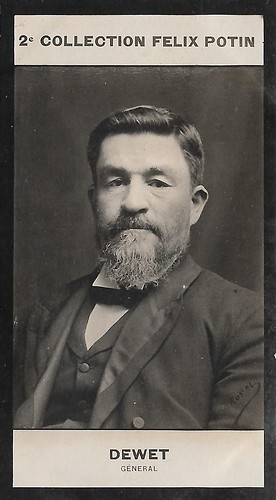
French minicard by Chocolat Félix Potin, Second Series, 1908. Photo: Russel.
Christiaan Rudolf de Wet (1854-1922) was a South African Boer general and politician.

French minicard by Chocolat Félix Potin, Second Series, 1908. Photo: Pierre Petit, Paris.
French painter, decorator and illustrator Guillaume Dubufe (1853-1909) was known for his decorations of ceilings of the foyer at the Comédie-Française, the Lobau Gallery at the Hôtel de Ville, the banquet hall at the Élysée Palace, and the library at the Sorbonne. He also decorated the famous restaurant Le Train Bleu. When not staying at their mansion in Paris, his family stayed at their villa on the Isle of Capri, where he painted scenes of his home. Dubufe was the son of Édouard Dubufe, who was one of the most famous portraitists of the Second Empire.
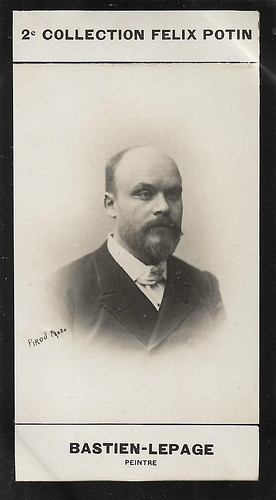
French minicard by Chocolat Félix Potin, Second Series, 1908. Photo: Pirou.
Jules Bastien-Lepage (1848-1884), was a French naturalist painter, an artistic style that emerged from the later phase of the Realist movement. His painting 'Les Foins' (Haymaking, 1877), now at the Musée d'Orsay in Paris, was widely praised by critics and the public alike.
For more cards, check out our Félix Potin album at Flickr.
No comments:
Post a Comment